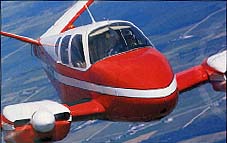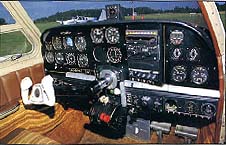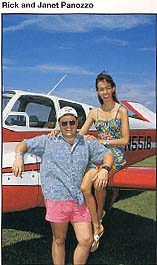

When talking about Rick Panozzo's airplane at Oshkosh this year, it got really confusing. Folks would call it a Twin Bonanza which it is, but it's not. In av-jargon a Twin Bonanza is the hulking 50 series Beech. Still, Rick's airplane IS a Twin Bonanza in the purest sense of the word.
The other phrase often heard when folks walked past his airplane went something like, "Wait a minute...what did I just see? Isn't that a Bonanza with two engines?"
The airplane Rick brought to Oshkosh is technically a Bay Aviation Super "V" and to answer the next question, no, it is not a one-off aberration produced by letting a Bonanza and a Beech Travelair spend too many lonely nights together in a hangar. But, we're getting ahead of ourselves.

Rick is pretty much an airport kid made good. He's flying DC-8 freighters on international routes now, which suites him fine as he earned his captain's stripes the hard way, one hour at a time.
A Minnesota boy from birth, he calls Cove Bay home, when he's not somewhere overseas. In 1979, while still in high school, he decided he had to learn to fly and began hanging around the Brainard airport. One thing lead to another and before long he found himself putt-putting over the end of the runway making his first solo flight in an Aeronca Chief. Shortly thereafter, he bought what would be the first in a long line of airplanes, a Stinson 10A. At the time he was 16 years old and the Stinson became his first restoration project. It also became his first serious time-builder which gave him a lot of flight time for his age when he went looking for CFI work after earning that rating.
 As
with most young pilots, it was as an instructor he really learned
to fly while building flight time. There's nothing like trying
to straighten a student out to iron out your own kinks. He instructed
in everything he could, but it was his time instructing in the
E-50 Twin Bonanza (the big Twin Bonanza), that got him one of
his first serious flying jobs. A company had a cloud seeding operation
in western Kansas using U-8 Twin Bonanzas and he was a natural.
He had all the right prerequisites. Twin Bonanza time. He was
young. He was time-hungry. And he hadn't properly assessed what
the job entailed.
As
with most young pilots, it was as an instructor he really learned
to fly while building flight time. There's nothing like trying
to straighten a student out to iron out your own kinks. He instructed
in everything he could, but it was his time instructing in the
E-50 Twin Bonanza (the big Twin Bonanza), that got him one of
his first serious flying jobs. A company had a cloud seeding operation
in western Kansas using U-8 Twin Bonanzas and he was a natural.
He had all the right prerequisites. Twin Bonanza time. He was
young. He was time-hungry. And he hadn't properly assessed what
the job entailed.
Technically the work was referred to as "rain augmentation" or "hail suppression", but either way it meant that he spent an inordinate amount of time flying in close proximity to squall lines and storms. Not all of the work was as simple as flying close and dropping silver iodide. In fact, as he puts it, "I was young and stupid. Sometimes the VSI would peg at 6,000 feet up and even with the power all the way off and the gear out, we'd still be going up at 500 fpm."
Turbulence was an integral part of the job and it was turbulence that made him decide there might be a better, smarter way to make a living.
"I came back from a flight with the dihedral of the airplane increased by several degrees and the counterweight on the left engine torn loose and rattling around inside."
Now that's what you call turbulence!
 His
next flying stint was much tamer, as he was flying loads of biologists
out over the Gulf of Mexico. Two of them would lay in the glass
nose of the converted Twin Beech (D-18 this time) to count dolphins.
Sometimes his missions would run as long as 10 hours.
His
next flying stint was much tamer, as he was flying loads of biologists
out over the Gulf of Mexico. Two of them would lay in the glass
nose of the converted Twin Beech (D-18 this time) to count dolphins.
Sometimes his missions would run as long as 10 hours.
Next it was Be99's for a commuter and finally DC-8's with a "real" airline.
From day one, regardless of where or what he was flying during his day job, there was at least one "fun" airplane accompanying him. Even during his hectic days trying to squeeze rain out of Kansas clouds, he managed to have his own airplane, in this case, a C-195.
"I bought the 195 from Bill Brennand in Oshkosh, but I was so young, I didn't even realize who I was talking to."
He also started looking around at various warbird projects, including a Mesquito and a Hunting Pembroke.
At the time he started flying DC-8s, he was "...watching the little military jets coming into the country." He quickly became part of that action when he bought four Jet Provosts. He sold two and used the others as the basis to start his own museum, War Birds of the World, which he still operates, only now it includes several new additions, including a MiG-15 and a CASA jet.
And then the Super "V" Bonanza came into his life. When he stumbled on to it, it had been sitting for some time. In fact it had been seven years since it had seen day light under the tires. At the time, he knew only the basics about the airplane, but learned quickly.
 Contrary
to what most of us in aviation think, what appears to be a quickie
conversion that may or may not be that practical, the Bay Aviation
(originally Oakland Aeromotive) Super "V" turns out
to be an interesting airplane with a little known history. On
top of that, it's a terrifically good performing airplane.
Contrary
to what most of us in aviation think, what appears to be a quickie
conversion that may or may not be that practical, the Bay Aviation
(originally Oakland Aeromotive) Super "V" turns out
to be an interesting airplane with a little known history. On
top of that, it's a terrifically good performing airplane.
First, what appears to be a Bonanza on which someone hung two 180 hp Lycomings (with pressure carbs) is much more than that. In fact, the airplane has so little pure Bonanza left in it that it has its own Type Certificate. It was not done as a modification using a Supplemental Type Certificate. The FAA considered it an entirely different airplane.
The program was in full swing in 1955 using small tail, 1953 "C" model Bonanzas as the basis for its conversions, or whatever you want to call them. They stayed with the small tail airplanes although the larger tail had come out because they felt the aft fuselage of the initial large tail airplanes wasn't strong enough for their purposes.
The entire airframe was radically modified including replacing the steel tube carry-through of the original Bonanzas with a hefty aluminum web type spar. This foreshadowed Beech Aircraft's eventual inclusion of the same type of structure by several years and, in fact, Rick says the Bay Aviation spar is 30% stronger than that used by Beech. Then the wing spars were increased in size and the wings generally beefed up in all areas, including new flap tracks. The number of formers in the aft fuselage was doubled and a new schnozz was built to streamline the place where the Continental used to hang. That became a baggage compartment of generous proportions.
The final product was an impressive performing airplane. In fact it was such an impressive airplane that Bay Aviation entered into an agreement with Fleet Aircraft of Canada in which Fleet would begin producing the airplanes from scratch under the new Type Certificate. It is unknown how far Fleet got in pre-production planning because the company reportedly began to have problems with other aspects of its business and decided to pull their horns in. The Super "V" program was left entirely in Bay Aviation's hands.

Rick says the records show a total of nine were modified/built with three still on the registry. He's unsure how many are flying but we've seen at least two, including his.
Rick loves the airplane and, when you hear the numbers, you can understand why.
Rick has flown the airplane enough that he's confirmed all his numbers over and over. For instance, at 65% and 8,000 feet the airplane trues an honest 205 mph while burning only nine gallons a side. 18 gallons total. The single engine ceiling is an impressive 11,000 feet and Rick reports it gives a solid 410 fpm single engine climb at sea level. Single engine minimum controllable speed is 84 mph, but it stalls at 62 mph. Rick says when he's working a short strip, it comes off in 400 feet and he waits in ground effect for a few seconds until Vmc shows up.
What's really important about the airplane are the loads it will carry. Its four tanks will hold a total of 100 gallons of fuel, which isn't that unusual for a twin. However, with this twin, you can put 100 pounds in the nose baggage, 75 pounds in the back baggage, put four full-sized adults in each seat and still carry full fuel. The useful load is a whopping 1530 pounds. Since Rick seldom flies it with all the seats full or full baggage he almost never gets even close to the gross weight of 3,400 pounds.
When asked what effect the modifications have on the renown "Bonanza Boogie" V-tailed Beeches are known for, Rick reports the dance is there but is less noticeable. It is as if having the extra weight out on the wings spreads the inertia and damps everything out.
Rick has no idea who owns the Type Certificate, as Bay Aviation went out of business years ago, but the fact the TC exists somewhere raises some intriguing possibilities. Anyone want to start producing an interesting, good performing airplane?
Even though his airplane is a near orphan, Rick says its a "keeper," if only because even a guy who owns a bunch of jets needs a transportation machine. And who wants an airplane just like everyone else? Judging from the reaction of the crowd at Oshkosh, it can safely be said he has accomplished his goal of finding a unique, but thoroughly useful, airplane. BD